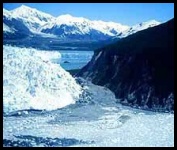
 Glaciers Surge Toward Lower Ground! Glacial motion can be difficult to predict. In 1986, the Hubbard Glacier in Alaska's Russell Fjord suddenly began to surge at the rate of 30 feet / 9 meters per day, creating a sizeable lake at the mouth of the fjord. The Tokositna Glacier, on the south side of Alaska's Mount Huntington, sometimes begins to surge down the mountain with loud rumblings and snapping sounds as the ice moves and breaks. And the massive glaciers of western Greenland, where 90% of North Atlantic icebergs come from, are among the fastest moving in the world - moving up to 4½ miles / 7 km per year. But the record for the fastest glacial surge goes to the Kutiah Glacier in Pakistan. In 1953, it raced more than 7½ miles / 12 kilometers in three months, averaging about 367 feet / 112 meters per day. Watch out! Finding the reasons for a glacier surge can be difficult. It could be climate change, earthquakes, or even the build-up of melting water beneath the ice.
Click pictures for more information and credits. Library: Glaciers, Icebergs, Arctic Links: Glaciers, Icebergs, Arctic News Story: Tokositna Rumbling! Glacier Map, Arctic Maps & Weather Reports |

|
DICTIONARY: Just "double-click" any unlinked word on this page for the definition from Merriam-Webster's Student Electronic Dictionary at Word Central. |

|
ARCTIC LIBRARY & GLOSSARY: Check this section for an index of the rest of the things you really need to know about the Arctic. |

|
ARCTIC MAPS & WEATHER REPORTS: Maps of the Northwest Passage, explorers' routes, iceberg sources, Nunavut, the Arctic by treeline, temperature... |

|
ARCTIC LINKS: Even more information! Links to sites related to the Arctic and "Iceberg: the Story of the Throps and the Squallhoots". |

|
GUIDE TO ARCTIC SUNRISE & SUNSET: How much sunlight or darkness is there in the Arctic on each day of the year? |
to is the property of their respective owners, and Athropolis is not responsible for their content.